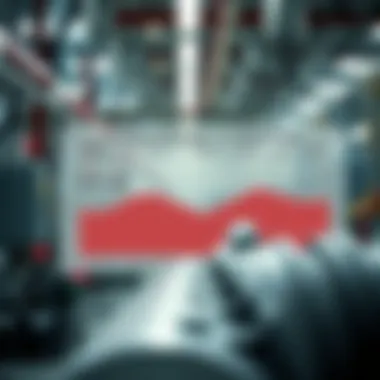Exploring Multi-Phase Electric Systems: Principles and Applications


Article Overview
Purpose of the Article
In this article, we aim to simplify the notion of multi-phase electric systems. These systems are an evolving area of electrical engineering, poised to revolutionize how we think about power generation, transmission, and utilization. Through a detailed analysis, we will break down the fundamental principles that govern these systems and explore their applications. Our purpose is to provide insights that not only illuminate the functionality of multi-phase systems but also underline their importance in today’s world of technology and sustainable energy solutions.
Relevance to Multiple Disciplines
Multi-phase electric systems touch numerous sectors—ranging from industrial machinery to renewable energy technologies. Their impact resonates across:
- Engineering: Offering solutions to enhance efficiency in power systems.
- Renewable Energy: Playing a vital role in wind and solar installations.
- Automation: Enabling precise control in manufacturing and robotics.
Understanding the depth of multi-phase systems equips students, educators, and professionals alike with necessary knowledge to innovate and improve existing technologies.
Research Background
Historical Context
Electric systems have come a long way since the days of early experimentation with direct current. The shift towards alternating current paved the way for multi-phase systems, particularly in the 1880s. The advent of three-phase systems, driven by the works of notable engineers, brought about a significant leap in efficiency.
These developments laid the groundwork for how electricity is distributed and utilized globally, marking an epoch where multi-phase systems became the standard for power generation, known for transmitting energy over long distances without substantial losses.
Key Concepts and Definitions
Understanding multi-phase systems begins with some core concepts:
- Multi-Phase Power: A system in which several alternating currents of the same frequency are generated, but they are out of phase with one another.
- Phasor Representation: A way to visualize the magnitude and phase angle of current and voltage.
- Balanced Loads: Occurs when currents in all phases are equal, ensuring stability and efficiency.
With these definitions in hand, we can explore deeper issues, like the advantages these systems hold over traditional single-phase systems.
Multi-phase systems are not just about efficiency; they represent a fundamental shift in how we understand energy distribution in the modern age.
Multi-phase systems are not just about efficiency; they represent a fundamental shift in how we understand energy distribution in the modern age.
Prelude to Multi-Phase Electricity
Understanding multi-phase electricity is not a casual walk through the park; it's more akin to deciphering an intricate puzzle with several pieces that fit together to form a cohesive picture of modern electrical systems. This section lays the groundwork for our exploration into multi-phase systems, emphasizing their role and necessity in today's fast-paced technological landscape.
Definition and Overview
At its core, multi-phase electricity refers to systems that deliver electric power using more than one voltage wave at any given moment. The most common configurations include two-phase and three-phase systems. These systems create a more efficient method for power generation and distribution, compared to traditional single-phase systems, potentially paving the way for reduced wiring costs and improved operational reliability. Have you ever wondered how big factories run heavy machinery without tripping a fuse? Well, that’s where the genius of multi-phase systems shines.
In practical terms, a three-phase system balances loads across three conductors, allowing for increased power density while minimizing losses due to heat. This balancing act results in machines that run smoother and last longer.
Historical Context
To appreciate where we are today, it’s wise to take a step back. The journey toward multi-phase systems traces its roots to the late 19th century, when innovators like Nikola Tesla kick-started a revolution in electrical engineering. His pioneering efforts birthed the alternating current (AC) system—a game changer that paved the way for modern power distribution. It wasn't just about passing the baton from one generator to another; it involved a seismic shift in thinking about power as a commodity we could harness more effectively.
Initially, electricity generation was bulky, inefficient, and fraught with challenges. As the need for reliable and scalable electricity soared, electrical engineers began experimenting. The introduction of three-phase systems in the early 1900s marked a significant milestone. As industries grew, so did the demand for multifaceted electrical systems that could keep pace with emerging technology.
The growing reliance on renewable energy sources today continually revitalizes interest in multi-phase systems, highlighting their ability to integrate and optimize diverse sources like wind and solar energy. This historical context reminds us that the evolution of electric systems is not merely a timeline of inventions but a response to the ceaseless demand for sustainability and efficiency in an increasingly electrified world.
"The measure of intelligence is the ability to change." — Albert Einstein
"The measure of intelligence is the ability to change." — Albert Einstein
Multi-phase electricity stands as a testament to our adaptability and innovation, reshaping how we understand and utilize power.
By delving into the fundamentals of multi-phase systems, we prepare ourselves to grasp the principles, applications, and challenges they present. This exploration not only sheds light on historical progress but also sets the stage for forward-thinking solutions that can benefit industries and society alike.
Fundamental Principles of Multi-Phase Systems
The realm of multi-phase systems offers an intriguing landscape that forms the backbone of modern electrical engineering and energy distribution. Understanding the fundamental principles is crucial, as they illuminate how multi-phase systems operate, their advantages, and the considerations that shape their design. Having a solid grasp of these principles helps students, researchers, and professionals in tackling real-world applications, particularly in industries demanding efficient and reliable power.
Basic Electrical Concepts
Voltage
Voltage is often thought of as the electrical pressure that pushes current through a circuit. In multi-phase systems, its significance is amplified. Multi-phase systems typically operate at higher voltages, which helps in transmitting power over long distances with reduced losses. Voltage maintains the necessary energy levels required for equipment and enables the scaling of systems to meet industrial demands.
One key characteristic of voltage is its ability to minimize energy losses during transmission. Higher voltage translates to lower current for the same power, which is beneficial because lower current reduces the resistive losses in transmission lines. However, this aspect is a double-edged sword. While higher voltage is efficient, it also comes with the added challenge of managing insulation and safety. In simple terms, higher gets you further, but you must ensure everything remains secure.
Current
Current, on the flip side, represents the flow of electric charge. In multi-phase systems, the way current behaves is pivotal. Notably, multi-phase configurations often distribute load more evenly among phases, leading to reduced neutral currents and enhanced stability. The balancing act of current in multiple phases results not only in efficiency but also improves the overall performance of electrical machines.
A key characteristic of current in multi-phase systems is its phase relationship. The synchronized flow can harness power more effectively, which is why it stands out in an industrial context. However, this complex nature does carry its burdens; any imbalance in the current can lead to overheating and equipment malfunction. Thus, while current is the life-blood of electricity, managing its flow is crucial for reliable operation.
Power
Power is the rate at which energy is transferred or converted in a system. It is closely tied to both voltage and current, with the equation of power typically noted as P = VI, where P is power, V is voltage, and I is current. In multi-phase systems, power calculation incorporates phase differences, enhancing the accuracy and reliability of energy distribution.
A standout feature of power in multi-phase systems is its capability to deliver more power with lower current due to the combined contributions from multiple phases. This characteristic is particularly beneficial in large industrial settings where high power is required. However, with increased power comes the obligatory need for robust management strategies to ensure connection stability and fault resistance, especially when sudden power surges occur.
Phase Relationships


Phase Angle
The phase angle is a key element in understanding how various phases relate to one another. In a three-phase system, for example, the sine waves representing each phase are offset from one another by 120 degrees. This offset allows for a continuous power flow and reduces voltage fluctuations.
A crucial characteristic of the phase angle is its role in determining the power factor. The power factor is a measure of how effectively electrical power is being transformed into useful work output. Understanding the phase relationship between voltage and current has massive implications, particularly in industrial systems where efficiency translates into substantial cost savings.
However, mismanagement of phase angles might lead to reduced efficiency and increased losses, essentially throwing a wrench in the works.
Waveform Analysis
Waveform analysis examines the shape and form of current and voltage waveforms in a multi-phase system. It’s paramount for identifying distortions and ensuring that waveforms remain sinusoidal, which is vital for overall system performance.
A key characteristic here is the capacity to pinpoint harmonic distortions in the waveforms that could lead to inefficiencies and overheating. In the age of smart systems where real-time adjustments are a norm, waveform analysis becomes a practical approach to improving system reliability and efficiency. However, grappling with waveform management often comes with additional complexity that requires careful monitoring and adjustments.
Harmonics and Their Management
Harmonics refer to the distortion that occurs when the waveform of the current or voltage deviates from the ideal sinusoidal shape. In a multi-phase system, harmonics can introduce inefficiencies and affect overall system performance. The management of harmonics is therefore imperative as it significantly impacts the performance of electrical equipment.
Addressing harmonics involves strategies such as using filters and power factor correction devices. These remedies not only enhance system stability but also reduce the risk of damage to sensitive equipment. Yet, the challenge lies in the balance; excessive filtering could inadvertently alter the system dynamics, leading to new issues.
In summary, understanding these fundamental principles is not just an academic exercise but serves as the foundation for developing efficient, stable, and innovative multi-phase systems that meet the needs of the modern world.
In summary, understanding these fundamental principles is not just an academic exercise but serves as the foundation for developing efficient, stable, and innovative multi-phase systems that meet the needs of the modern world.
By grasping these concepts, stakeholders across the board—engineers, companies, and researchers—can harness the benefits of multi-phase electrical systems, guiding them toward solutions that are more efficient and sustainable.
For further reading on these topics, you might find the following resources useful:
- Wikipedia: Multiphase Systems
- Britannica: Electrical Engineering
- ResearchGate for Academic Papers
- IEEE Xplore Digital Library
Types of Multi-Phase Systems
Understanding the different types of multi-phase systems is fundamental to grasping their applications and operational benefits. Multi-phase electric systems can be classified primarily by the number of phases they employ. Each type comes with its own set of characteristics, advantages, and specific use cases, making them crucial in various sectors including industrial applications, infrastructure projects, and renewable energy. Knowing the nuances of these systems allows engineers and practitioners to select the most fitting configurations for their needs, enhancing efficiency and performance.
Two-Phase Systems
Two-phase systems, though not as commonly implemented today, laid the groundwork for multi-phase designs. They consist of two alternating currents, typically 90 degrees out of phase. This phase relationship is essential because it allows the system to deliver a continuous rotation of power and ensures that motors operate smoothly.
Benefits of Two-Phase Systems:
- Smooth operation: The power delivery in a two-phase system provides a balanced load, minimizing vibration and noise, particularly in machines such as fans and pumps.
- Simplicity: Given their less complex nature, these systems tend to be easier and faster to implement than their three-phase counterparts.
Nonetheless, there are drawbacks. For example, two-phase systems experience increased wire length and may require more complex switching mechanisms than expected. These factors can render them less efficient in certain large-scale applications where space and resource optimization are paramount.
Three-Phase Systems
Three-phase systems are the most widely utilized form of multi-phase electricity today, primarily due to their superior efficiency in power distribution. A three-phase system uses three separate conductors transmitting currents that are each 120 degrees apart in phase. This configuration results in a series of fluctuating currents that provide consistent power.
Advantages of Three-Phase Systems:
- Higher Power Density: For the same amount of current, three-phase systems can deliver nearly 1.5 times the power of a single-phase system. This effectiveness makes them ideal for heavy machinery and industrial setups.
- Energy Savings: Because power is continuously flowing, systems can run more efficiently, leading to reduced energy costs over time.
- Reduced Conductor Size: In many instances, three-phase systems can employ smaller conductors to carry the same amount of power, reducing material costs and weight.
Many industries, such as manufacturing, rely on three-phase systems for their lower operational costs and the ability to support large equipment with minimal losses. The reliability and efficiency of three-phase power are often regarded as gold standards in electrical engineering resources.
Higher Phase Systems
Beyond the familiar three-phase configurations, higher phase systems can include four, five, or even higher numbers of phases. While these systems are less common in everyday applications, they are particularly valuable in specific situations demanding specialized performance metrics.
Characteristics of Higher Phase Systems:
- Enhanced Performance: Systems with higher phases can offer improved harmonic performance and efficiency when optimized properly. This can reduce losses in transformers and other components.
- Complicated Design Requirements: With the increase in phases, the complexity of the winding configurations and control strategies also rises. This can pose a challenge in both design and maintenance.
Applications of higher-phase systems could be seen in places like specialized motors or specific industrial applications where unique challenges are present, making them a potentially useful tool in engineering’s arsenal. They serve as a great example of how increasing complexity in phase configurations can yield considerable benefits in niche contexts.
It’s crucial to understand the necessity of selecting the appropriate multi-phase configuration to achieve optimal performance in electrical systems.
It’s crucial to understand the necessity of selecting the appropriate multi-phase configuration to achieve optimal performance in electrical systems.
Key Components and Configuration
Understanding the key components and configuration of multi-phase electric systems is crucial for harnessing their full potential. These systems rely on a blend of various elements working harmoniously to deliver efficient energy transmission and distribution. By grasping the intricacies of these components, one can appreciate their significance in practical applications and the benefits they offer over traditional single-phase systems.
Generators and Motors
Generators and motors serve as the backbone of multi-phase systems. At their core, generators convert mechanical energy into electrical energy. They operate based on electromagnetic induction, which means they generate electricity when there is relative motion between a conductor and a magnetic field. For instance, in a three-phase generator, three sets of coils, spaced equally, produce three alternating currents that are out of phase by 120 degrees, ensuring smoother and steadier power delivery.
On the flip side, motors transform electrical energy back into mechanical energy. They work in reverse to generators and are widely used in industry and transportation. A three-phase motor, for example, delivers higher torque and efficiency compared to single-phase counterparts, making it ideal for heavy-duty applications such as manufacturing and conveyor systems. The harmony between generators and motors in multi-phase configurations is fundamental to maintaining system stability and performance.
Transformers
Another essential component in multi-phase systems is the transformer. These devices facilitate voltage regulation, allowing the transmission of electricity over long distances with minimal losses. They operate on the principle of electromagnetic induction to step up (increase) or step down (decrease) voltage levels as required.
Multi-phase systems often utilize three-phase transformers, which can efficiently manage phase shifts and balance loading across the phases. This capability not only enhances the efficiency of power distribution but also minimizes issues like phase imbalances which can lead to overheating and equipment damage. In addition, advanced transformer designs such as auto-transformers and phase shifting transformers offer even more options for managing power quality in diverse applications.
Switching Devices
Switching devices in multi-phase systems manage the flow of electricity, ensuring safety and efficient operation. They allow operators to control the circuit by opening or closing pathways for current. Different types of switching devices include circuit breakers, contactors, and relays.


A circuit breaker, for instance, automatically interrupts electrical flow to prevent overloads. In three-phase systems, special designs are required to ensure that all three phases are balanced, reducing the risk of failure. Similarly, contactors enable remote control of equipment, allowing for energy management in industrial settings. Additionally, relays provide a means to automate switching without direct human intervention, streamlining operations in complex systems.
"The configuration of components directly influences the performance of multi-phase electric systems, emphasizing the need for careful planning and selection of these critical elements."
"The configuration of components directly influences the performance of multi-phase electric systems, emphasizing the need for careful planning and selection of these critical elements."
In summary, the synergy among generators, motors, transformers, and switching devices forms the bedrock of multi-phase electric systems. Their unique configurations and operational principles empower a wide array of applications in industries, showcasing the tremendous potential of these systems for future energy solutions. Understanding these components not only highlights their operational significance but also paves the way for innovative advancements in electrical engineering.
Advantages of Multi-Phase Systems
Multi-phase systems offer a variety of benefits that make them particularly well-suited for modern electrical applications. Understanding these advantages not only helps in appreciating the workings of multi-phase systems but also highlights their superiority compared to conventional single-phase systems. The importance of recognizing these benefits lies in their implications for efficiency, energy conservation, and overall performance in various fields of technology.
Improved Efficiency
One of the standout features of multi-phase systems is their superior efficiency. In essence, these systems enable better power delivery with less waste. This is largely due to the reduced ``voltage drop'' experienced across long distances when multiple phases are applied.
For instance, three-phase systems can transmit the same power as single-phase systems with a lower current, leading to less power loss along the transmission lines. When you cut down on waste, you effectively enhance the overall operational efficiency of electrical systems. The reduction in current not just means lower resistive losses but also translates to the ability to use smaller and less costly conductors.
Another key point is the smoother operation of motors powered by multi-phase electricity. Each phase produces a rotating magnetic field which guarantees a continuous and stable torque. This leads to better performance in motors, allowing for higher starting torque and reducing wear and tear compared to their single-phase counterparts.
Reduced Energy Loss
Reducing energy loss is critical for both environmental factors and economic considerations. Multi-phase systems excel in this regard. The distributed nature of phases minimizes the losses that typically occur in single-phase systems. When comparing two systems of equal load, multi-phase setups have lower losses due to the reduced current flow and improved load characteristics.
Additionally, modern multi-phase converters play an important role in enhancing energy efficiency in renewable energy applications, such as wind turbines and solar power. These technologies offer increased energy capture and better voltage regulation, resulting in less energy lost in the conversion process. This not only contributes to efficiency on an operational level but also plays a crucial part in addressing sustainability goals on larger scales.
Higher Power Density
When it comes down to power density, multi-phase systems shine brightly. Power density refers to the amount of power output per unit area. Multi-phase electric systems efficiently deliver higher power levels while maintaining compact components, making them ideal for applications where space is at a premium.
For example, in electric vehicles, having a higher power density allows manufacturers to use smaller motors that yield the same power equivalent to larger single-phase motors. This smaller size not only reduces the weight of the vehicle but also enhances performance, letting these vehicles achieve higher speeds and better acceleration.
Moreover, compact systems contribute to more straightforward integration into various applications. Higher power densities allow engineers and designers more flexibility in the layout of electrical systems, whether in dense urban environments or vast industrial settings.
"In a world increasingly focused on sustainability and efficiency, the benefits of multi-phase systems align with the critical need for modern energy solutions."
"In a world increasingly focused on sustainability and efficiency, the benefits of multi-phase systems align with the critical need for modern energy solutions."
Applications of Multi-Phase Electric Systems
The exploration of multi-phase electric systems reveals a plethora of applications that cater to various sectors, showcasing their unparalleled significance in modern technology. These systems don’t merely operate as a theoretical construct; they serve real-world functions, forming the backbone of industries and renewable energy sectors. Understanding these applications helps illuminate why multi-phase systems are gaining traction, especially when it comes to enhancing efficiency, reliability, and sustainability.
Industrial Applications
Manufacturing
In the realm of manufacturing, multi-phase electric systems provide businesses with the power necessary to keep production flowing smoothly. The most appealing aspect of utilizing these systems lies in their ability to drive heavy machinery with sturdy and consistent power. Unlike traditional single-phase systems that may falter under heavy loads, multi-phase systems offer stability and reduce the risk of voltage drops. This property is particularly advantageous when operating multiple machines simultaneously, as it ensures that each piece of equipment receives adequate power, leading to enhanced productivity.
Key characteristic: The ability to distribute power evenly.
This fundamental feature allows manufacturing plants to run hefty machines like lathes and CNC mills efficiently. However, while there are many upsides, one must also consider potential downsides, such as the complexity involved in designing and maintaining these systems. Still, for most manufacturing sectors, the benefits tend to outweigh these challenges.
Pumping Systems
Turning to pumping systems, multi-phase setups shine once again. Their proficiency is vital in scenarios where high capacity and reliability are paramount—think water treatment facilities or oil pipelines. A distinctive element of multi-phase pumping systems revolves around their inherent capacity to maintain steady flow rates over extensive distances.
Key characteristic: Enhanced flow efficiency.
By harnessing this characteristic, industries can effectively transport fluids without necessitating extensive energy input, making it a cost-effective choice. Yet, as with any technology, the initial investment and installation complexities can be daunting. Despite these hurdles, the advantages of energy savings and efficient operation make multi-phase systems a choice worth considering in this area.
Renewable Energy Integration
Wind Energy
In an age where sustainability reigns supreme, wind energy integration into multi-phase systems presents exciting prospects. Utilizing multi-phase technology in wind turbines permits a higher conversion efficiency from mechanical to electrical energy. This capability is instrumental, especially as wind farms scale up in size and number.
Key characteristic: Higher energy conversion efficiency.
The innovative designs used in wind energy systems allow for smoother operation and less wear on components, prolonging the lifecycle of the equipment. However, incorporating multi-phase systems into renewable energy projects can introduce complexities that need skilled professionals to navigate.
Solar Power
On the solar front, solar power systems benefit significantly from multi-phase electric configurations. When solar arrays are designed to operate in a multi-phase framework, they achieve improved load balancing and energy distribution. This feature becomes especially vital during peak generation periods, as the systems can manage the fluctuations efficiently.
Key characteristic: Improved load management.
This adaptability enhances the effectiveness of solar panels in delivering power to the grid. Nevertheless, while integrating these systems can propel solar technology, initial installation and component costs can be high, making it a hefty commitment for many. However, the long-term return on investment often justifies these considerations.
Transportation Systems
Electric Vehicles
Diving into electric vehicles, the role of multi-phase systems becomes increasingly critical. These designs are favorable because they handle higher currents without overheating, a common pitfall in single-phase systems. As the market gravitates towards electric vehicles, the demand for efficient charging infrastructure employing multi-phase systems makes perfect sense.
Key characteristic: Capacity to handle high currents.


This aspect not only optimizes charging times but also contributes to overall system reliability. Yet, the transition to multi-phase systems adds potential complications for infrastructure upgrades, necessitating careful planning and investment from stakeholders.
Rail Systems
When it comes to rail systems, multi-phase power management emerges as a fundamental component for electric trains. High-speed trains often utilize this technology to maintain consistent performance across varied speeds and loads. The intricacies of multi-phase power systems allow for smooth acceleration and safety, rendering them essential for modern rail networks.
Key characteristic: Consistent performance across different speeds.
While installation can be complex and require rigorous safety standards, the network resilience it provides cannot be overstated. This makes multi-phase systems a pivotal player in enhancing the efficiency of public transport.
Multi-phase electric systems stand as pillars of modern energy solutions, playing a crucial role in optimizing industrial productivity, renewable energy sources, and transportation methods.
Multi-phase electric systems stand as pillars of modern energy solutions, playing a crucial role in optimizing industrial productivity, renewable energy sources, and transportation methods.
Challenges in Multi-Phase Systems
Multi-phase electric systems are heralded as a cornerstone in modern electrical engineering, yet they are not without their hiccups. Understanding the challenges associated with these systems is crucial for both practitioners and academics involved in design, implementation, and maintenance. This section will unpack some of the significant hurdles—design complexity, cost factors, and issues around system stability and control.
Design Complexity
Designing multi-phase systems is not a walk in the park. Unlike simpler, single-phase systems, multi-phase configurations tend to incorporate a variety of components that bring their own quirks. For example, in a typical three-phase motor setup, the alignment and synchronization of the phases must be meticulously considered.
There are several reasons why the intricacies of design pose challenges:
- Component Interaction: With multiple phases, the behavior of the entire system can be sensitive to the characteristics of individual components. Any mismatch can lead to inefficiencies or operational inefficiencies.
- Load Balancing: Ensuring that loads are balanced across multiple phases requires careful planning and measurement. Unbalanced loads can lead to overheating or premature failure of devices.
- Thermal Management: The more components in play, the more heat generated; managing that heat becomes increasingly complex.
The intricate nature of these systems means that a one-size-fits-all approach simply doesn't cut it. Each application demands tailored solutions, making it harder to predict behaviors or potential failures.
Cost Factors
When embracing multi-phase systems, cost factors are a significant consideration that can't be brushed aside. The notion of investing in advanced technology is tempting, yet costs can skyrocket quickly. Here’s what often drives up expenses in multi-phase systems:
- Initial Investment: The upfront costs for components such as generators and transformers, especially when high-quality equipment is needed, can be heavy on the wallet.
- Installation and Maintenance: Specialized knowledge is needed for both setup and ongoing maintenance. This can require skilled labor, further driving up costs.
- Energy Costs: Operating multiple phases can sometimes necessitate additional energy consumption, leading to higher bills. If one isn't careful, the promise of improved efficiency can backfire as operating costs increase.
Smart budgeting can mitigate some of these issues, but a thorough cost-benefit analysis is key for decision-making.
System Stability and Control
Another pivotal challenge lies in ensuring system stability and control in multi-phase setups. This issue can often be a double-edged sword: with more phases, there comes greater complexity, which can jeopardize stability. Considerations include:
- Dynamic Loads: The inherent instability caused by varying loads can complicate control schemes. Rapid fluctuations in demand, for example, require real-time adjustments that can be hard to achieve reliably.
- Feedback Mechanisms: The design of effective feedback control mechanisms is crucial for maintaining stability. Poorly designed feedback can lead to oscillations or even catastrophic failures.
- Interference: In a multi-phase environment, unwanted interactions can occur between phases, leading to unpredicted outcomes. This complexity means engineers must employ sophisticated control systems to keep everything running smoothly.
Despite these challenges, the solutions often lead to more resilient and capable systems. Advances in technology and control methodologies hold promise for overcoming these difficulties in the future, enabling wider adoption and engineering innovations.
"Understanding the challenges in multi-phase systems allows engineers to chart more effective roads to solutions, thereby enhancing system reliability and performance."
"Understanding the challenges in multi-phase systems allows engineers to chart more effective roads to solutions, thereby enhancing system reliability and performance."
Future Directions in Multi-Phase Electric Systems
The landscape of electrical engineering is on the brink of transformative changes, particularly in the domain of multi-phase electric systems. These systems offer multiple opportunities to enhance efficiency and integrate renewable energy solutions. As we step into the realm of future directions, it is essential to understand how technological advancements and smart grid configurations might redefine our approach to energy consumption and distribution in the coming years.
Advancements in Technology
Recent innovations in materials and engineering techniques are revolutionizing the way we think about multi-phase systems. For instance, the development of high-temperature superconductors is a game changer. With these, power losses typically associated with electrical resistance can be dramatically reduced. Furthermore, advancements in power electronics are paving the way for more efficient switching and control methods in multi-phase systems. These technologies are making it easier to manage power delivery, reduce costs, and enhance overall performance. As a result, efficiency is not just an abstract concept; it becomes a tangible goal.
Integration with Smart Grids
The synergy between multi-phase systems and smart grids is an exciting frontier. Smart grids leverage advanced communication and control technologies to optimize the distribution and consumption of electricity. When combined with multi-phase systems, they enable a more dynamic response to energy demands, thereby stabilizing the grid and enhancing reliability. Not only that, but smart grids also facilitate demand response strategies, allowing consumers to adjust their energy usage based on real-time conditions. This integration holds promise for reducing peak loads and enhancing the resilience of energy infrastructure.
"The future of energy lies in the symbiosis of multiple technologies working in harmony, and multi-phase systems will play a vital role in this evolution."
"The future of energy lies in the symbiosis of multiple technologies working in harmony, and multi-phase systems will play a vital role in this evolution."
Potential Research Areas
As we look forward to the future, several key areas of research are ripe for exploration.
- Energy Storage Solutions: Investigating how multi-phase systems can enhance the effectiveness of energy storage technologies, like batteries or flywheels.
- Grid Interconnections: Studying the viability of multi-phase systems in linking disparate energy sources into a cohesive network.
- Environmental Impact: Evaluating the environmental benefits of widespread adoption of multi-phase systems in reducing carbon footprints.
This commitment to furthering research and development is not just about improving existing systems. It's about reimagining how we deliver and consume energy in our everyday lives. As the world pivots towards sustainability, the exploration of multi-phase electric systems remains a crucial part of the conversation, anchoring technological progress within a framework of responsibility toward future generations.
Epilogue
The importance of concluding a detailed exploration of multi-phase electric systems extends far beyond mere summary recaps. As we’ve journeyed through the varied facets of this complex topic, it becomes clear that multi-phase systems are not just a technical marvel, but a pivotal element in shaping the energy landscape of the future. In this article, the critical considerations are not merely highlighted but woven into a narrative that speaks to their significance.
Summary of Key Insights
In wrapping up our discussion, several key points emerge that deserve reiteration:
- Efficiency and Performance: Multi-phase systems generally demonstrate enhanced efficiency compared to their single-phase counterparts. This can translate to lower operational costs and improved performance in both industrial and renewable settings.
- Diversity in Application: The varied applications of multi-phase systems span from industrial manufacturing to renewable energy generation. Their versatility makes them essential in current and future energy paradigms.
- Innovation and Development: With advancements in technology, the field of multi-phase systems is poised for growth. New materials, control strategies, and integration methodologies offer significant promise for enhanced performance.
- Challenges Ahead: Despite their benefits, these systems also present challenges that must be navigated, including cost implications and system complexity. As we head toward a more electric future, addressing these challenges remains critical.
Overall, it’s the combination of theory, application, and practical challenges that offers a comprehensive view into the world of multi-phase electric systems.
The Role of Multi-Phase Systems in Future Energy Solutions
Looking into the future, multi-phase systems are set to play a crucial role in the evolution of energy solutions. As the world increasingly turns its attention to sustainability and efficiency, the capabilities of these systems provide fertile ground for innovation.
For instance, multi-phase electric systems can facilitate the integration of renewable energy sources, such as solar and wind, into the existing infrastructure. Their ability to manage varying loads and adapt to changes in energy production makes them indispensable.
Moreover, as smart grid technologies emerge, the adaptability and real-time performance of multi-phase systems will be essential. The interplay between electric vehicles, renewable energy generation, and grid management can be seamlessly catered to through effective multi-phase systems. Thus, their role is not only pivotal in the present landscape of energy solutions but is also geared towards addressing the complexities of tomorrow’s energy requirements.
In summary, the intersection of multi-phase electric systems and future energy solutions reflects a crucial pivot point for sustainable development and innovation in the realm of electrical engineering. Understanding this relationship enhances our efforts to cultivate a well-rounded, energy-conscious society.



